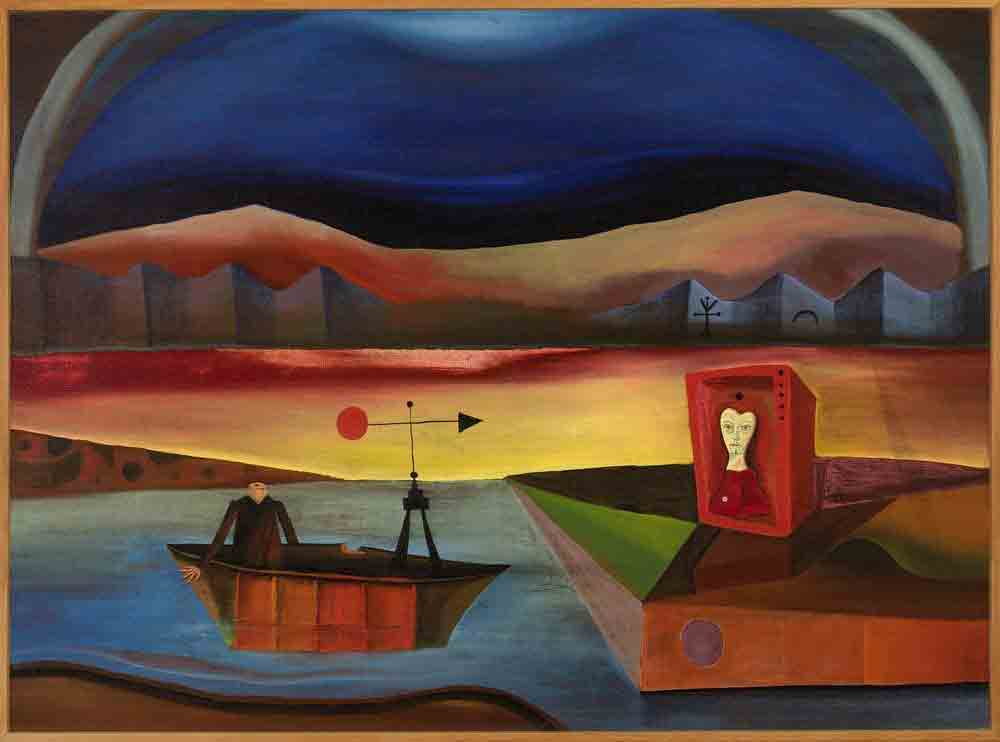
Modest Cuixart, Moon Fisherman (El Pescallunes), 1949
"Modest Cuixart paintings lead us to other scenes. Sometimes they evoke the atmosphere of festivals and magic, they are recognized as a fascination of the mystery."1
Modest Cuixart, Moon Fisherman (El Pescallunes), 1949
In 1936 the Nationalist forces of General Francisco Franco attacked the newly elected Popular Front government. For three years, the Spanish Civil War raged as Nationalists fought against Republicans. The war left hundreds of thousands dead and caused terrible suffering to all Spaniards.2 The aftermath, between the 1940s and 1950s, was a devastated socio-cultural situation, with damaged information and communication lines with Europe and the rest of the world, and artists facing censorship and oppression. In this context, a number of artists founded art groups that would help repair and integrate the cultural scene,as well as revive and reconnect the art world that was so rich before the war. One of the most important groups of the time was Dau al Set.3
Dau al Set was a Catalan group of writers and artists as well an art magazine of the same name. The name, which means "the seventh side of the die" in Catalan, implied that the group was going beyond the normal limits, since dice only have six sides. The group was connected through its Surrealist style, which used dream-like imagery and incongruous literature as its sources of inspiration.
In 1948 Modest Cuixart (Barcelona, 1925-2007) along with other fellow artists founded the magazine, which ran for six years. Dau al Set magazine's impact was very limited, since circumstances allowed only clandestine distribution among a select group within the intellectual elite interested in culture and art. It had a print run of between one hundred and two hundred copies. However, it was a space where many artists put forward their ideas-whether in words using essays, poems, and stories, or using images. Through the movement and the magazine they made clear their opposition to academic and official artistic circles. They became important because they promoted contemporary art in Catalonia, resurrecting the art scene after the cultural suppression of the Spanish Civil War. The group's works were inspired by the Dada and Surrealist movements and especially by German artists Max Ernst (1891-1976), Paul Klee (1879-1940), and by fellow Catalonian artist Joan Miró (1893-1983).
In 1944 Cuixart enrolled in university to study medicine, where he remained until 1946, when he decided to devote himself exclusively to painting. In his works, he combines geometric symbols like stars and arrows with strange figures and imaginary landscapes to create a dreamlike atmosphere that combines enigmatic and magical elements.
1. Granell and Guigon. Dau al Set. Pg. 148
2. Solomon R. Guggenheim Foundation, Arts Curriculum Online, Spanish Painting from El Greco to Picasso: Time, Truth, and History
3. Fominaya, Alvaro Rodriguez. The Inverted Mirror exhibition wall text. Bilbao, From January 1st 2012 to September 2nd, 2012
Preguntas
- Look carefully at Cuixart’s artwork. Take a few moments to observe every detail of the picture. What do you notice? What images do you recognize? What time of day does it seem to be? What makes you think that?
- Cuixart’s paintings of this period were set in magical, dreamlike settings, which characterized the Dau al Set group. Imagine stepping into the painting. What might you see, hear, smell, sense? How does it feel to be in this place? Do you like to be here? Why?
- If this were a dream, would it be a nightmare or a pleasant fantasy? What makes you think that?
- What are the characters in this scene doing? Imagine a conversation between the figures. Working in pairs, write a dialogue between them. What might they be talking about? How would their voices sound? Act out your dialogue using the “voice” of the figures. You can also add background sounds to the conversation.
